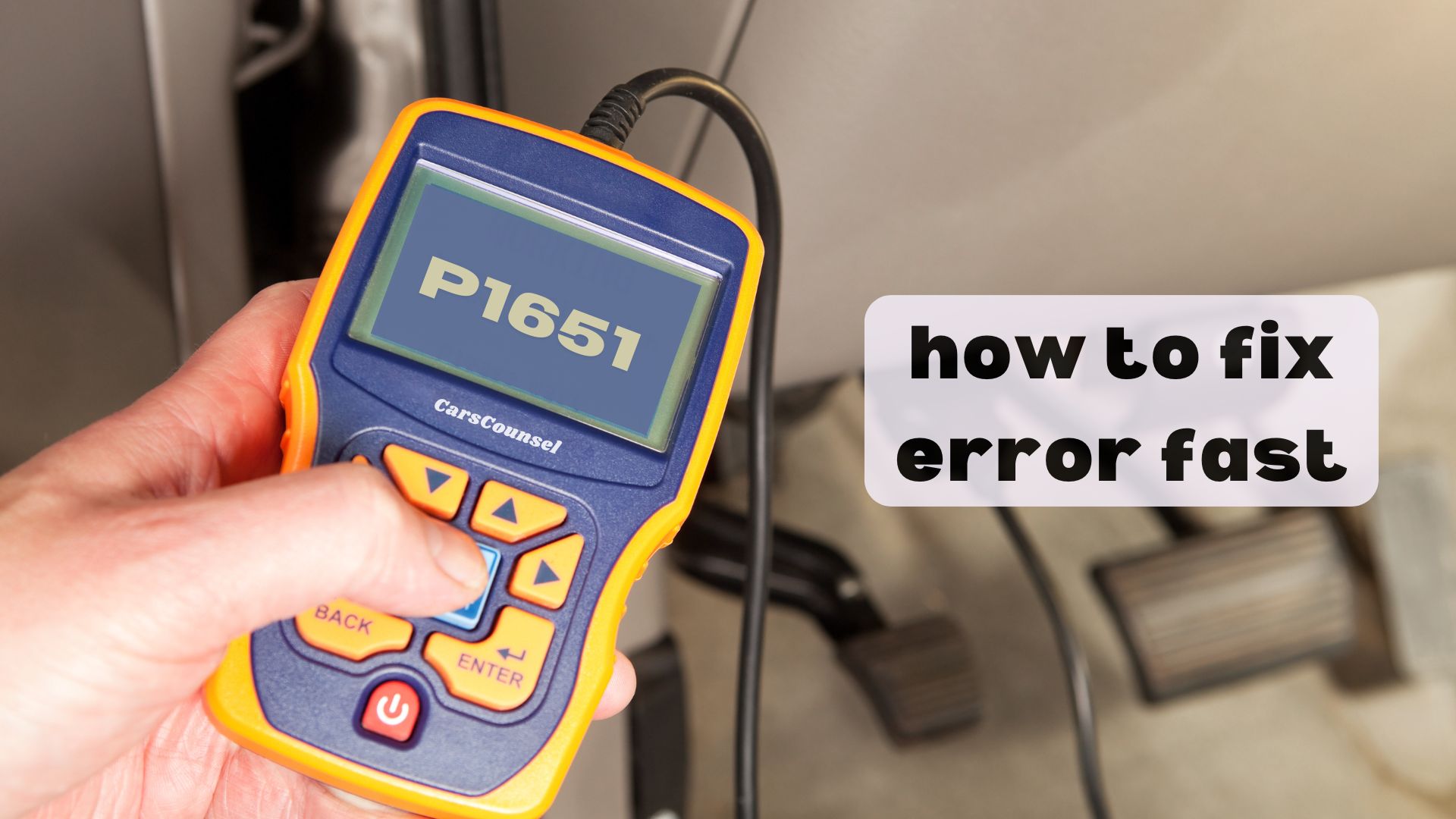As you navigate the complex terrain of your vehicle’s engine, a warning light flickers like a sentinel in the darkness, signaling a problem that’s been lurking beneath the surface. The P1651 code has appeared, casting a shadow over your engine’s performance. This cryptic message hints at a fault in the Powertrain Control Module‘s (PCM) output controls, but what lies beneath? Is it a faulty component, a software glitch, or something more sinister? The answer lies in the depths of your vehicle’s electrical system, waiting to be uncovered.

Quick Navigation
Key Takeaways
- The P1651 code indicates a fault in the Powertrain Control Module’s (PCM) output controls, affecting engine performance and potentially causing poor fuel efficiency and drivability issues.
- Common causes of the P1651 code include faulty PCM circuitry, wiring issues, software errors, and electrical system malfunctions.
- Diagnosing the P1651 code requires retrieving trouble codes, inspecting wiring and connectors, and testing the PCM module for software or programming errors.
- The cost to fix the P1651 code can range from $200 to $800, including parts and labor, depending on the complexity of the issue.
- Accurate diagnostics are crucial to identify the root cause of the problem, prevent misdiagnosis, and ensure the issue is fully resolved.
Code P1651 Description
When your vehicle’s onboard computer, the Powertrain Control Module (PCM), detects a fault in its output controls, it triggers the P1651 diagnostic trouble code (DTC).
This code indicates a problem with the PCM’s ability to regulate engine functions, which can lead to suboptimal Engine Performance.
As the brain of your vehicle’s engine management system, the PCM controls fuel injection, ignition timing, and emissions.
A faulty PCM output can cause poor fuel efficiency, erratic engine operation, and drivability issues.
The Check Engine Light may illuminate on your dashboard, signaling that it’s time to investigate and address the underlying issue affecting your Vehicle Electronics.
Common Causes of P1651
Faulty or malfunctioning components within the Powertrain Control Module (PCM) circuitry are a common culprit behind the P1651 code.
You’ll need to inspect the PCM circuitry for faulty connections, wiring issues, or corrosion that could be causing the malfunction.
A faulty PCM itself can also trigger this code, so you’ll need to test it using manufacturer-specific diagnostic procedures.
Additionally, software or programming errors in the PCM, as well as electrical system malfunctions affecting PCM communication, can also lead to the P1651 code.
Identifying and addressing these underlying issues is vital to resolving the problem.
Symptoms of P1651
Engine performance issues are often the first indication that something is amiss, and with a P1651 code, you may notice your engine stalling or running rough, especially when idling.
This can lead to poor fuel efficiency and reduced engine power. You may also experience poor acceleration and throttle response, making your vehicle feel sluggish.
Some common symptoms of a P1651 code include:
- Engine stalling or rough idling
- Reduced engine power
- Poor acceleration and throttle response
- Check Engine Light illuminated
- Vehicle may go into limp mode (limited performance to prevent further damage)
How to Fix P1651
To start diagnosing and fixing the P1651 code, you’ll need to use a diagnostic scanner to retrieve and record the trouble codes stored in the vehicle’s onboard computer.
Next, inspect the wiring harness and connectors for any signs of damage or corrosion.
Perform a faulty sensor diagnosis to identify any malfunctioning components.
If necessary, conduct an electrical system overhaul to guarantee proper communication between the PCM and other engine management systems.
Finally, clear the trouble codes and perform a test drive to verify that the issue has been resolved, and confirm that the repair has been successful.
Cost to Fix P1651
About $200 to $800 is what you can expect to pay to fix the P1651 code, including parts and labor.
This range in repair estimates is due to the varying complexity of the issue, which can involve faulty PCM components, wiring issues, or software errors.
To get an accurate estimate, it’s essential to have a qualified mechanic perform diagnostics.
- Importance of diagnostics:
- Identifies the root cause of the problem
- Helps determine the necessary repairs
- Prevents misdiagnosis and unnecessary repairs
- Guarantees that the issue is fully resolved
- Certifies you time and money in the long run
PCM Output Controls Fault Diagnosis
When diagnosing a P1651 code, you’ll need to follow a structured approach to identify the root cause of the PCM output controls fault.
Start by retrieving and recording the trouble codes using a diagnostic scanner.
Next, inspect the wiring harness and connectors for signs of damage or corrosion.
Use pcm troubleshooting tips to test the PCM module, checking for software or programming errors.
Faulty module diagnosis is vital, as a malfunctioning PCM can cause the code.
Follow manufacturer-specific diagnostic procedures to isolate the issue, and then repair or replace faulty components as necessary.
Troubleshooting PCM Communication Issues
As you inspect the wiring harness and connectors, pay close attention to the PCM communication lines, as issues with these can prevent the module from receiving or sending essential messages.
Weak PCM signal strength can disrupt communication with other vehicle modules, leading to faulty engine performance.
To troubleshoot PCM communication issues, check for:
- Corrosion or damage to PCM terminals or connectors
- Faulty wiring or connectors in the PCM circuit
- Software or programming errors affecting PCM communication
- Electrical system malfunctions impacting PCM signal strength
- Vehicle network topology issues, such as faulty bus communication
Repairing or Replacing the Powertrain Control Module
If your diagnostic tests point to a faulty Powertrain Control Module (PCM), you’ll likely need to repair or replace it to resolve the P1651 code.
If the issue lies in the software, a PCM reflash might be sufficient to update the module’s programming. However, if the problem is hardware-related, a Module upgrade or replacement might be necessary.
Be sure to consult your vehicle’s repair manual or manufacturer’s guidelines for specific procedures and recommendations. A qualified mechanic or auto repair shop can assist you in determining the best course of action for your particular situation.
More OBD-II Codes
| P1652 | P1655 | P1660 | P1661 |
| P1671 | P1672 | P1673 | P1674 |
| P1675 | P1676 | P1677 | P1678 |
| P1679 | P1680 | P1681 | P1117 |
| P1685 | P1686 | P1687 | P1688 |
| P1689 | P1691 | P1695 | P1155 |
Frequently Asked Questions
Can a Faulty Oxygen Sensor Trigger the P1651 Code?
You’re wondering if a faulty oxygen sensor can trigger the P1651 code. While it’s unlikely, a sensor malfunction can cause issues that might indirectly lead to PCM output control faults, such as a fuel injector issue, which could then trigger the code.
Will the P1651 Code Always Illuminate the Check Engine Light?
Your engine computer is like a maestro, orchestrating a symphony of functions, but when faulty wiring disrupts the harmony, the Check Engine Light may not always illuminate, as the P1651 code can sneak in silently, hiding in the shadows of your vehicle’s systems.
Can a Loose Battery Terminal Cause the P1651 Code?
You’re wondering if a loose battery terminal can cause the P1651 code. Yes, it can, as battery corrosion or poor terminal cleanliness can disrupt power supply to the PCM, leading to faulty output controls and triggering the code.
Is It Safe to Drive With a P1651 Code Illuminated?
You’re wondering if it’s safe to drive with the Check Engine Light on; however, compromised engine performance and poor fuel efficiency may lead to unpredictable driving conditions, making it risky to continue operating your vehicle without addressing the underlying issue.
Can a Tune-Up or Spark Plug Replacement Fix the P1651 Code?
You’re wondering if a tune-up or spark plug replacement can fix the issue. Unfortunately, it’s unlikely, as a tune-up typically focuses on fuel injector and ignition coil maintenance, which won’t address the root cause of the PCM output controls fault.
Conclusion
As you navigate the complex landscape of your vehicle’s engine, the P1651 code serves as a guidepost warning of a malfunctioning PCM output control. Like a conductor losing control of the orchestra, the faulty PCM throws the entire engine performance out of harmony. By following the diagnostic roadmap, you’ll uncover the root cause of the issue, whether it’s a software glitch or a hardware malfunction. With precision and patience, you’ll restore balance to your engine’s symphony, ensuring a smooth ride and peak performance.

